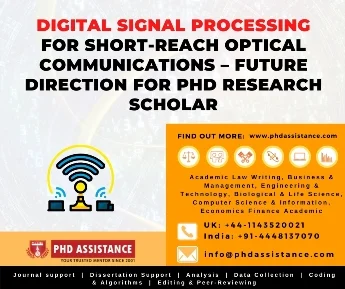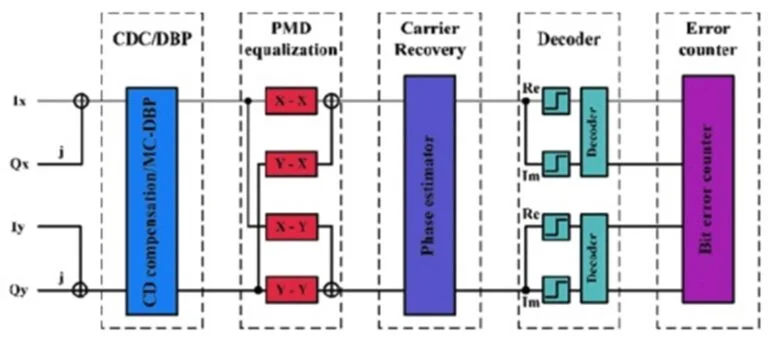Digital Signal Processing For Short-Reach Optical Communications – Future Direction For Phd Research Scholar
In-Brief
Short-reach optical communication has emerged as an key business segment and research field in recent years, fueled mostly by Cloud Service and data-center applications. Short-reach systems are distinguished by direct detection-based receiver configurations and other low-cost, small-form-factor components that cause transmission defects not observed in coherent systems. Innovative signalling and digital signal processing (DSP) are critical to allowing these components to reach their full potential and meet data rate needs while being cost-effective.

Introduction
Traditional fiber-optic communications [1] concentrated on high-speed connections over long distances around the world. New usages including the Internet of Things (IoT), Augmented/Virtual Reality, Cloud Computing, storage, and other software-as-a-service (SaaS) and Infrastructure-as-a-Service (IaaS) have increased demand for short-reach networks in data centres (DCs) in recent years.
According to a recent Cisco research, by 2020, 86 percent of worldwide Internet traffic would be DC linked, with 77 percent of that traffic occurring within a DC [2]. Content providers like Facebook, Google, Amazon, and others are driving such rapid growth in DC traffic. They have invested extensively in their own infrastructure in recent years and have replaced traditional telecommunication carriers as market drivers for optical transceivers, particularly for short-range connectivity. Digital coherent systems, in which all degrees of freedom of the optical carrier (amplitude, phase, and polarisation) are used to encode information, are possibly the most significant innovation in optical transceiver technologies over the last decade. In both polarizations, receiver digital signal processing (DSP) retrieves the whole field information. Transmission flaws such as chromatic dispersion (CD) and polarization-mode dispersion (PMD) become linear and may be simply and adaptively rectified [3].
In current year, the research community has worked hard to design DSP solutions for short-reach systems that are comparable to long-haul systems’ results. But, due to the minimal size of the market for short-range transceivers, cost is the primary concern, preventing direct application of the digital coherent system idea to short-range links. Transceiver form factors are also critical because port density, or the total number of physical connections and bit rate per area, is a crucial element in determining the overall size and energy consumption of DC. These limits place unprecedented demands on physical layer devices, necessitating novel signalling, sensing, and DSP methodologies to accomplish next-generation DC for the aforementioned applications.
Channel model and dsp for long-haul vs short-reach systems
The current generation of DSP research for short-reach networks is built on developments in long-haul digital coherent systems over the last decade. An overview of coherence detection and DSP for long-haul systems is presented here, followed by a discussion of restrictions unique to short-reach systems that leads to new DSP research directions.

Source: Xu, T. (2017).
Canonical digital coherent systems for long-haul optical communications
Coherent detection developed one of the most important technologies in the creation of high-speed, high-spectral-efficiency, dynamically reconfigurable optical networks for long-distance transmission. A coherent receiver allows information symbols to be encoded in all degrees of freedom available in a fibre by recovering the electric field in the two fibre polarizations, resulting in enhanced power and spectral efficiency. Digital compensation can be done either before up-conversion onto an optical carrier or after the optical signal has been down-converted to the electronic domain at the receiver. In both circumstances, if the baseband signal in the electronic domain is sampled above the Nyquist rate, the digitised signal has all of the information of the analogue electric field, allowing DSP compensation to execute without loss of performance when compared to analogue impairment compensation in either the optical or electronic domain.
Unique challenges for short-reach systems
The unique challenges that stimulate new DSP approaches for short-reach devices are multi-fold.
Cost: High-performance devices for the market of low-cost short-reach transceivers. Furthermore, direct detection is preferable to coherent detection. Because of the lack of TEC and wavelength locking devices, simplified DSP is highly sought, and channel spacing is substantially bigger than typical 50 GHz international telecommunication union (ITU) grids.
Form factor: While small form factors are desirable for all types of optical transceivers, they are critical for DC applications because they affect port density, rack size, which directly translates to the overall size of DCs, the amount of cooling/air conditioning required, and hence total energy consumption.
Latency: Because of supercomputing and other delay-sensitive Cloud applications, DC systems have higher latency tolerance than long-haul systems. In addition, propagation delays are substantially less in short-reach systems than in long-haul networks, and there are fewer connection components to cause additional signal delays.
Different types of short-reach systems and their respective challenges
| Type | Length scale | Features and limiting factors | Challenges |
| Inter-data center | <20km | Rs, CD | O-band transmissions as alternative |
| ER inter-data center, metro and access | <80km | CD | Fully coherent transceivers eventually |
Recent research in Digital Signal Processing for Short-Reach Optical Communications
| S.No | Techniques | Future Scope | Reference |
| 1 | DSP+ Deep Learning +Optical Fiber Communications | Low-cost
optical communications to increase reach or enhance the data rate at shorter distances. |
[5] |
| 2 | deep neural network+Unrolling algorithm | The findings may bring newer enhancements to semi-supervised/unsupervised learning methodologies, as well as practical benefits when working with minimal training data or resource-constrained platforms. | [7] |
| 3 | DSP+ reconfigurable filters | RIS technology
is often mentioned in 6G research, now is the right time to explore these open problems. |
[8] |
| 4 | DSP+ optical communication | Single-channel 1Tbit/s transmission was recently demonstrated [2] and further developments into commercial transceivers are expected in the near future. | [9] |
Conclusion
In this blog stated the various DSP techniques that enable high capacity transmissions for short-reach systems. Advanced modulation formats and direct detection are typically used due to cost constraints. DSP techniques are essential to overcome component bandwidth limitations, impairments introduced by nonlinear modulation characteristics in the transmission channel. Future efforts on joint optimization of optical components and DSP techniques may become a key area of growth. This may also enable gradual introduction of many coherent detection functionalities into future short-reach optical communication systems.
Refernces
- Kareem, F. Q., Zeebaree, S. R., Dino, H. I., Sadeeq, M. A., Rashid, Z. N., Hasan, D. A., & Sharif, K. H. (2021). A survey of optical fiber communications: challenges and processing time influences. Asian Journal of Research in Computer Science, 48-58.
- Fraser, S., & Mancl, D. Exploring the Dimensions of University-Company Collaborations: Research, Talent, and Beyond.
- Fu, J., Chen, S., Xue, Y., & Bi, C. (2021, April). Estimation of OSNR using ADTP and convolutional neural network under different chromatic dispersion. In 2021 6th International Conference on Intelligent Computing and Signal Processing (ICSP)(pp. 1260-1268). IEEE.
- Zhang, T., Xiang, Q., Zhang, S., Liu, L., Sygletos, S., & Zuo, T. (2021). Cost-effective digital coherent short-reach transmission system with D8QAM and low-complexity DSP. Optics Express, 29(8), 11892-11902.
- Karanov, B., Chagnon, M., Aref, V., Ferreira, F., Lavery, D., Bayvel, P., & Schmalen, L. (2020, October). Experimental investigation of deep learning for digital signal processing in short reach optical fiber communications. In 2020 IEEE Workshop on Signal Processing Systems (SiPS) (pp. 1-6). IEEE.
- Khan, F., Ghaffar, A., Khan, N., & Cho, S. H. (2020). An overview of signal processing techniques for remote health monitoring using impulse radio UWB transceiver. Sensors, 20(9), 2479.
- Sarieddeen, H., Alouini, M. S., & Al-Naffouri, T. Y. (2020). An overview of signal processing techniques for terahertz communications. arXiv preprint arXiv:2005.13176.
- Monga, V., Li, Y., & Eldar, Y. C. (2021). Algorithm unrolling: Interpretable, efficient deep learning for signal and image processing. IEEE Signal Processing Magazine, 38(2), 18-44.
- Zhong, K., Zhou, X., Huo, J., Yu, C., Lu, C., & Lau, A. P. T. (2018). Digital signal processing for short-reach optical communications: A review of current technologies and future trends. Journal of Lightwave Technology, 36(2), 377-400.
- Björnson, E., Wymeersch, H., Matthiesen, B., Popovski, P., Sanguinetti, L., & de Carvalho, E. (2021). Reconfigurable intelligent surfaces: A signal processing perspective with wireless applications. arXiv preprint arXiv:2102.00742.

